In 2005 the remains of a 4,000 year old bowl of “millet grass” noodles were discovered at an archeological site near the Yellow River in China, giving much weight to the claim that pasta was invented in Asia. (And I thought contemporary Asian noodles were diverse!) Whatever its origin, pasta has played a prominent role in the Asian diet for centuries and its popularity is easily understood: Noodles are filling, inexpensive, and versatile. They may be eaten hot or cold, pan-fried or stir-fried, enjoyed in soups or salads, dressed up or served virtually unadorned. And with the right ingredients, they can be a healthy, satisfying meal in themselves.
The following Asian noodle primer is designed to demystify the often overwhelmingly vast noodle selection in Asian markets—and these days in many mainstream supermarkets, as well. With some difficulty (because I am an Asian noodle–holic), I have narrowed the list down to the following 10 must-know noodles.
 |
Cellophane Noodles (a.k.a. Bean Threads) Cellophane noodles are made from the starch of mung beans, which are perhaps more familiar in the form of bean sprouts (the large sprouts are used raw and cooked in many Asian cuisines). The dried noodles are opaque white, but once softened in hot water, they turn silky and transparent, absorbing the flavors of the foods they are cooked with. Cellophane noodles are used primarily in Chinese cuisine, in stir-fries and soups. Notable examples include the Sichuan stir-fry classic “ants on a tree” and Mongolian hot pot. They can also be dropped into smoking-hot oil, so that they explode in size and become crisp; then they are used as a bed, or a “bird’s nest,” for such dishes as Cantonese stir-fried chicken with vegetables. |
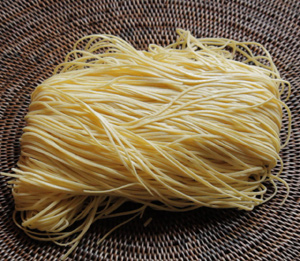 |
Chinese Egg Noodles Well-stocked Asian markets typically offer a selection of fresh and dried thin and thick egg noodles. Unfortunately, they are often neon yellow, due to the artificial coloring that is added. (Many varieties don’t even contain eggs.) For this reason, I usually prefer to buy the “fresh” angel hair pasta sold in the refrigerated section of most supermarkets. I use thin egg noodles for pan-fried dishes and delicate soups; and thicker noodles such as fettuccine or linguine for heartier dishes such as cinnamon beef noodle soup, or as a bed in a cold noodle salad with spicy peanut sauce. |
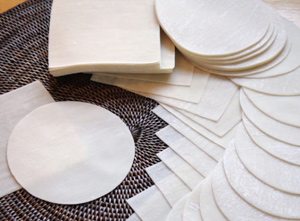 |
Dumpling Wrappers Wonton skins, shao-mai, and gyoza skins are some of the names that dumpling wrappers may take in Chinese and Japanese dishes. They are now widely available in Asian specialty shops and in well-stocked supermarkets. Generally, the round white-wheat-flour-and-water wrappers are used for pan-fried, boiled, and steamed dumplings; square wrappers, made with an egg dough, are most frequently used for boiled and deep-fried Chinese wontons. Fresh wrappers will keep up to a week in the refrigerator and may be frozen up to three months. |
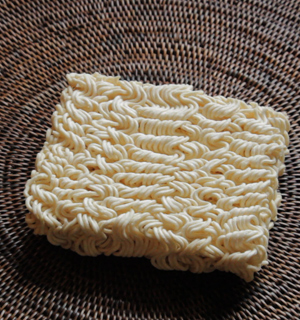 |
Ramen Many Americans are familiar with Japanese ramen from the packages of instant dried noodles they see in their supermarkets and variety stores. Ramen noodles are usually made with an egg dough and are descendants of Chinese egg noodles. Fresh or dried ramen can be found in some Japanese markets; they are cooked as you would any egg noodle, in lots of boiling water until al dente. In Japan, ramen is a classic and much beloved soup, consisting of noodles served in a meat- or fish-based broth, topped with assorted meats, seafoods, and vegetables (toppings vary from region to region). Since ramen noodles are difficult to find fresh, I frequently substitute the instant version (discarding the flavoring packet) or use angel hair noodles. |
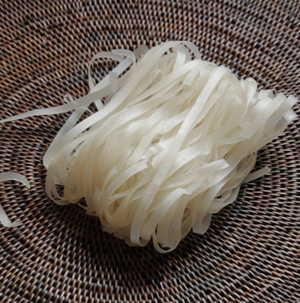 |
Rice Noodles Made of rice powder and water, rice noodles are sold in Asian markets and come in so many varieties it can be overwhelming. Unfortunately manufacturers do not have a standardized system for naming them so it’s easy to get confused. When shopping, look at the size and shape of the noodles rather than the name. Delicate strands of extra-thin rice vermicelli are softened in hot water and used in Chinese, Vietnamese, Thai, and Malaysian soups for their textural subtlety. They are extremely versatile, as evidenced by their appearance in Vietnamese spring rolls and assorted Thai, Malaysian, and Vietnamese salads and stir-fries. Vermicelli can also be deep-fried in very hot oil and served as crisp “nests” for stir-fried dishes. Rice stick noodles come in three main sizes. The thinnest are cooked in soups and occasionally stir-fried in Chinese, Thai, and Vietnamese dishes. Medium-size rice sticks are generally used in soups, stir-fries, and salads (the most popular are known as pho and are used in a Vietnamese soup of the same name). The slightly wider Thai version, jantaboon noodles, is served in the classic stir-fried dish pad thai or Thai-style spicy beef. |
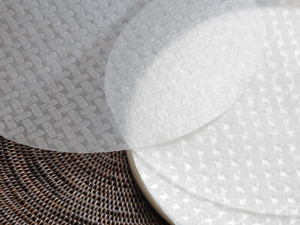 |
Rice Paper Wrappers: Banh trang, or rice paper wrappers, are available in both round and triangular shapes and are made of rice flour and water. The unique pattern on the sheets is created when they are dried on bamboo trays. Once dipped briefly in hot water, the brittle, dried wrappers become soft and translucent. The round wrappers are used for roll-ups and Vietnamese, Thai, and Laotian spring rolls and the triangular ones are used to wrap grilled meats or in deep-fried dishes. |
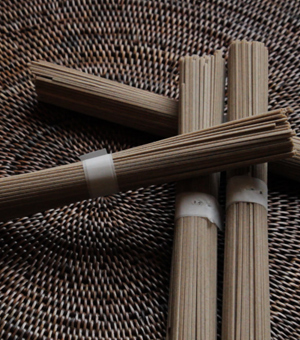 |
Soba These brownish buckwheat noodles from Japan are appealing not only for their nutty flavor but also for their nutritional value—they are rich in protein and fiber. In Japan, soba makers are likened to master chefs and soba is considered a classic delicacy. The noodles are commonly served cold with a dipping sauce or hot in soups with meat or seafood and vegetable toppings. Dried soba can be found in well-stocked supermarkets, health food stores, and Asian specialty markets. (Japanese brands are generally of higher quality than Western varieties.) |
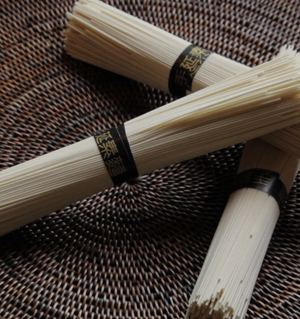 |
Somen The most delicate Japanese noodles, somen, are often distinguished by their elegant packaging and can be found in well-stocked Asian markets. They are made from a wheat flour–and-water dough with a little oil. Like soba, they may be served cold with a dipping sauce or hot in delicate soups. |
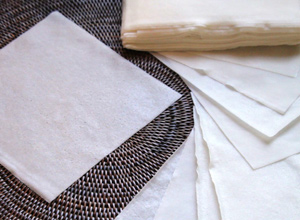 |
Spring Roll Skins (a.k.a. Lumpia Wrappers) While Western cooks are most familiar with Cantonese egg roll wrappers made with an Italian pasta-like egg dough, many Chinese cooks prefer these lacy skins made by rubbing a wheat flour–and-water dough over a hot grill. Spring roll skins (called lumpia wrappers in Filipino cuisine) are lighter and more delicate than Cantonese egg wrappers and, once fried, are crisper. They are sold frozen in Asian markets and can also be steamed lightly or deep-fried in spring rolls. |
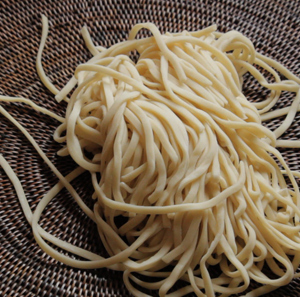 |
Udon Dried and fresh udon noodles, which look like standard flour-and-water noodles, are sold in many mainstream supermarkets. Once cooked, however, udon become zaftig, white, slippery noodles, most commonly used as the centerpiece of robust Japanese soups and casseroles. They may also be served cold with various simple toppings such as nori, ginger, wasabi, and scallions. Their shape varies—they may be round, square, or flat. In Japan, as with soba, the making of udon is an art and udon chefs are likened to masters. Udon noodle recipes are diverse, but a favorite is nabeyaki udon, or chicken udon noodle soup with spinach in a dashi (a Japanese kelp-based broth). Another popular favorite is udon miso soup. |
Nina Simonds is one of the United States’ foremost authorities on Asian food and culture. She is the author of 11 cookbooks, including the forthcoming Simple Asian Meals. Learn more about her and watch her videos at spicesoflife.com.


 Pinterest
Pinterest


